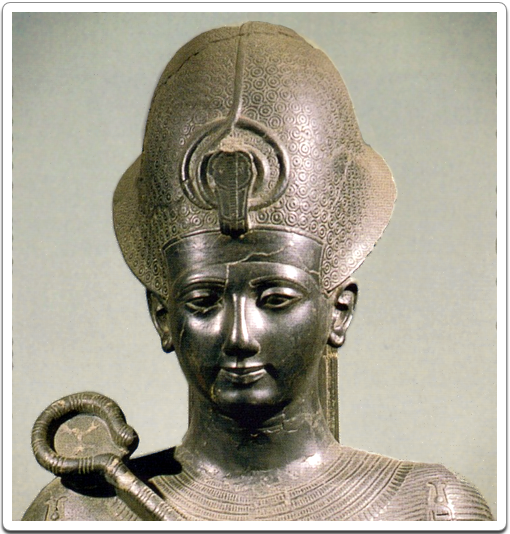The expulsion of the Hyksos, began during the late 17th Dynasty by Seqenenre or by Kamose and completed by 18th Dynasty monarch Ahmose in 1522, was the start of a series of conquests that would bring Egypt peace and prosperity. The age of conquest had begun!
Even though Ahmose was the brother or nephew of his predecessor, Kamose, Manetho has placed him at the head of a new royal house: the 18th Dynasty.
In an effort to secure Egyptian borders against future invasions, Ahmose conquered a territory stretching from Syria-Palestine in the North, to the 2nd cataract in Nubia in the South. Within a few decennia, Egypt became the most powerful nation in the Ancient Near East.
Head and torso of a colossal statue of the ‘heretic’ pharaoh Akhenaten.
Ahmose’s aggressive policy against Asia and Nubia was followed by his successors, especially by Thutmosis I and Thutmosis III, who expanded the boundaries of the new empire as far as the 4th cataract to the South and as far as the Euphrates River near the modern-day Turkish border in the North.
The spoils brought home from the many successful military campaigns and the tributes owed by the many conquered states increased Egypt’s wealth and prosperity, which was translated in a tremendous building activity: new temples were built, older ones were restored or enlarged. Especially favoured were the god Amun and his great temple at Karnak, in the capital Thebes.
Egypt’s stability was briefly ruptured when the late 18th Dynasty king Amenhotep IV, also known as Akhenaten, changed the Egyptian religion and had most temples closed, favouring one new god, the solar-deity Aton. During this period of turmoil and upheaval, the so-called Amarna-revolution, Egypt is believed to have lost a lot of its former influence in Asia and Nubia. This loss, however, may, at least, also have been the result of the changing political situation in that region, resulting in a stronger and more influential Hittite empire.
The first kings of the 19th Dynasty, Seti I and Ramesses II, set out to restore Egypt’s lost glory, reclaiming the lost territories abroad and continuing the formidable building activity started in the 18th Dynasty. Again, large parts of Asia were conquered, but the international situation had changed and the Egyptians found themselves facing a new and powerful enemy: the Hittites.

Head of a statue of Ramesses II, wearing the blue crown, often associated with warfare.
The enmities between Egypt and the Hittites came to an end in the 21st year of Ramesses II’s year with a peace treaty between the two countries. The remainder of the 67-year long reign of Ramesses II would be peaceful and prosperous.
With the 20th Dynasty, Egypt’s half millennium of prosperity and relative stability would slowly draw to an end. Although Ramesses III was clearly a very capable ruler who had successfully repelled several foreign invasions and was able to restore the Egyptian influence in Syria-Palestine, his reign was also marked by corruption, social turmoil and a conspiracy that may well have ended his life!

The highly fortified entrance to Ramesses III’s temple and palace at Medinet Habu has been seen as a sign of the country’s growing political instability. Yet for all its fortification, a plot that may have resulted in the King’s death, could not be prevented.
During the years following his death, Egypt’s unity and stability started falling apart: the Theban priests of Amun were becoming more and more the de facto rulers of Upper-Egypt, while Lower-Egypt was in the hands of the administration of the Pharaoh. Another powerful group in the Egyptian society were the military, especially the military who descended from former Libyan prisoners of war. They too claimed their part in the government and in Egyptian territory.
By the end of the 20th Dynasty, Egypt was again divided into many fractions and the New Kingdom came to an end.
Click on the thumbnails below to learn more about the dynasties of the New Kingdom: